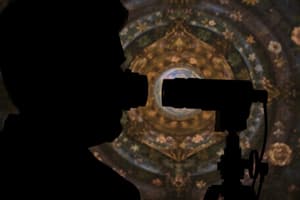Podcast
Questions and Answers
What unit of measurement is used for luminance in perimetry?
What unit of measurement is used for luminance in perimetry?
- Candelas
- Apostilbs (correct)
- Lumens
- Decibels
A zero decibel (0 dB) is the dimmest stimulus on all perimeters.
A zero decibel (0 dB) is the dimmest stimulus on all perimeters.
False (B)
What does WANDER stand for in the context of visual field report interpretation?
What does WANDER stand for in the context of visual field report interpretation?
WHAT WAS DONE
The standard test area for central vision in visual field testing is _____ degrees.
The standard test area for central vision in visual field testing is _____ degrees.
Match the following strategies used in visual field testing with their descriptions:
Match the following strategies used in visual field testing with their descriptions:
What is the acceptable threshold for fixation loss in a visual field test?
What is the acceptable threshold for fixation loss in a visual field test?
Fixation loss can be accurately assessed even when the blind spot is enlarged.
Fixation loss can be accurately assessed even when the blind spot is enlarged.
What do we call the number of times a patient responds to an audible click when no target stimulus is presented?
What do we call the number of times a patient responds to an audible click when no target stimulus is presented?
Short-term fluctuation in visual field examination is measured in _____ between readings.
Short-term fluctuation in visual field examination is measured in _____ between readings.
Match the following terms with their definitions:
Match the following terms with their definitions:
Flashcards are hidden until you start studying
Study Notes
Visual Field Testing Overview
- Visual field testing evaluates pathological eye conditions, particularly those affecting retinal function.
- Modern perimeters generate complex printouts that require careful interpretation.
Importance of Knowledge in Optometry
- Knowledge is equated with sight in optometry, emphasizing the importance of understanding visual field data.
Apostilbs and Decibels
- Luminance in perimetry is measured in apostilbs, an absolute unit.
- Decibels (dB) measure sensitivity on a relative scale and vary by device; 0 dB signals the brightest stimulus.
WANDER Interpretation Scheme
- WANDER aids in systematically interpreting visual field reports:
- What was done?: Identify test area and strategy.
- Test areas: 10°, 24°, 30°, 60°.
- Strategies: Full Threshold, Screening, Fast Test (e.g., SITA FAST, Top).
- Fixation Loss: Measures patient’s engagement with the test. Should be less than 33% for reliability.
- False Positive: Indicates when a patient responds to an audible cue rather than visual stimuli.
- Short-term Fluctuation: Normal range is 1-2 dB; >2 dB suggests poor reliability.
- What was done?: Identify test area and strategy.
Evaluating Normal vs. Abnormal Fields
- Assess the field's normality by analyzing gray scale and numerical values.
- Gray Scale: Provides a visual impression but is not fully reliable due to limited test points.
- Numerical Values: Reflect retinal sensitivity relative to age. The normal decay rate of sensitivity is 0.5 to 1.0 dB per decade.
Total and Pattern Deviations
- Total Deviation: Compares patient's retinal sensitivity to age-corrected norms.
- Pattern Deviation: Adjusts measured thresholds based on generalized changes to assess localized defects.
- Pattern Deviation Probability (PDP): Visualizes deviations beyond expected norms for age.
Global Indices for Interpretation
- Developed by perimeter manufacturers to aid clinicians in interpreting results:
- Mean Deviation (MD).
- Pattern Standard Deviation (PSD).
- Corrected Pattern Standard Deviation (CPSD).
- Short-Term Fluctuation (SF).
Clinical Significance of Mean and Pattern Deviations
- Mean Deviation: Represents the overall height of the visual field.
- Pattern Standard Deviation: Reflects the shape of the field.
- Thresholds:
- Normal MD and PSD indicate an intact visual field.
- Abnormal findings can suggest generalized depression or localized defects, with specific thresholds indicating severity of depression.
Summary of Findings Interpretation Table
- MD and PSD combinations help determine field health:
- Normal MD and PSD: Normal visual field.
- Abnormal MD with normal PSD: Generalized depression; no focal defects.
- Normal MD with abnormal PSD: Localized defects present.
- Abnormal MD and PSD: Severe localized defects.
These notes encapsulate key concepts and procedures related to visual field testing that are crucial for understanding and interpreting results in optometry.
Studying That Suits You
Use AI to generate personalized quizzes and flashcards to suit your learning preferences.




